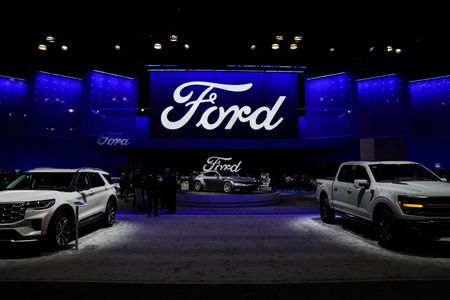By Nora Eckert and Nathan Gomes
DETROIT (Reuters) – Ford Motor on Wednesday projected up to $5.5 billion in losses on its electric vehicle and software operations this year, a loss similar to last year and a sign of the severe difficulties in cutting costs on battery-powered models.
The automaker forecast overall profitability for 2025, but even that was lower than in 2024. For the fourth quarter, it reported a net profit of $1.8 billion, up from a loss of $500 million in the year-ago quarter as pension-related costs weighed on results.
The company’s shares were down nearly 5% in after-hours trading.
Ford’s chief executive, Jim Farley, has been seeking to follow up a choppy 2024 with more consistent results, in a year that is already shaping up to be marred by swings in U.S. policy.
The Dearborn, Michigan, automaker is working to overcome persistent quality issues and lift its stock price which declined by 18% last year. It now faces uncertainty around U.S. President Donald Trump’s threatened tariffs on Mexico and Canada. If implemented, the measures would boost the automaker’s raw material costs and likely hurt sales demand.
Farley told analysts on a conference call that Ford could weather a few weeks of tariffs, but that if 25% duties on Mexico and Canada were prolonged, “it would have a huge impact on our industry, with billions of dollars of industry profits wiped out, and adverse effect on the U.S. jobs.” Farley added he believes that Trump is aiming to strengthen the auto industry, not weaken it.
The company’s fourth-quarter revenue of $48.2 billion surpassed analyst expectations of $43 billion, according to LSEG data. Adjusted earnings per share of 39 cents also beat analyst forecasts of 33 cents per share.
Farley made some significant cuts to the company’s EV plans last year, axing a much-anticipated three-row electric SUV and delaying the launch of its next generation electric F-150 Lightning truck. The company is leaning heavily on its California “skunkworks” team developing EVs from the ground up, and said the first affordably priced vehicle from that team will be a mid-sized electric pickup arriving in 2027.
While Ford is not rolling out new EVs in the coming year, a contrast to General Motors which is introducing a blitz of new models and ramping up sales of its Blazer and Equinox EVs, Farley is leaning heavily on hybrids, which GM is not rolling out until 2027.
Ford’s EV losses include significant investment in future models, and it is also increasing volume while cutting costs by $1.4 billion, said Sherry House, Ford’s incoming chief financial officer.
Ford sold roughly double the number of hybrids compared with its EVs last year, with 187,426 hybrids sold and 97,865 EVs.
The automaker’s multi-powertrain approach “should help it mitigate any adverse impact on sales from the elimination of the federal EV tax credit, as opposed to a company such as GM who bet very aggressively on battery EVs,” said Garrett Nelson, analyst for CFRA Research. The Trump administration has eyed removing a $7,500 consumer tax credit available on certain EVs.
The company projected lower earnings before interest and taxes of $7.0 billion to $8.5 billion for 2025. It met its annual guidance for 2024 after narrowing it late last year, recording annual EBIT of $10.2 billion.
Among the challenges facing Ford this year is a tougher pricing environment, House said, and the automaker is planning for about 2% lower industry pricing.
TARIFF TURMOIL
Ford is the first major automaker to report earnings since Trump signed an executive order on Saturday stating that the U.S. would impose 25% tariffs this week on goods from Mexico and Canada, which would affect Ford as well as cross-town rivals GM and Stellantis. However, Trump delayed the decision for a month after discussions with each country’s leader.
The automaker did not factor in tariffs to its annual outlook, executives said.
Farley told analysts that any tariff policy implemented would have to be “comprehensive for our industry,” adding that Asian rivals are able to import vehicles into the U.S. with “no incremental tariff.”
Tariffs on Mexico would affect Ford’s popular Maverick pickup truck, one of its most affordable vehicles, the Bronco Sport, as well as the Mustang Mach-E SUV, which are assembled in Mexican plants. Analysts have said of the Big Three Detroit automakers, Ford is the least exposed to tariffs. GM and Stellantis produce more profit-rich vehicles outside the United States.
Last month, Executive Chair Bill Ford told reporters that Trump called him “out of the blue.”
“He understands the importance of our industry and of Ford in the industry,” Bill Ford said, referring to Trump. The Ford chairman added that he was “very confident that Ford will have a voice, and a seat at the table.”
(Reporting by Nora Eckert in Detroit and Nathan Gomes in Bengaluru; Editing by Sayantani Ghosh and Matthew Lewis)









